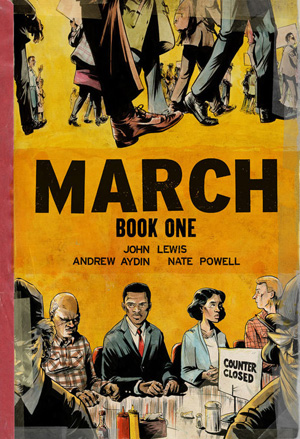Marching for Justice
March: Book One
When I heard about this one, I knew I’d have to get it.
It’s basically the autobiography of civil rights leader and Congressman John Lewis, in graphic-novel format. The project came about because some of his staff were making jokes about staffer Andrew Aydin, who was a comics fan, but Lewis pointed out that a comic book about Martin Luther King, Jr. helped inspire him to get involved in the civil rights movement. Soon, Aydin was co-writing this book with Lewis, while Nate Powell put the art together.
Though the book starts out with what’s probably the most horrifying incident of Lewis’ life — when state troopers attacked peaceful marchers and fractured his skull on the Edmund Pettus Bridge in Selma, Alabama — we soon settle into a more straightforward biography. We visit Lewis as a child, obsessed with being a preacher and delivering passionate sermons to the family’s chickens as practice. We watch him growing up, going to college, becoming more socially aware, meeting Martin Luther King, becoming an activist…
Approximately the last half of the book focuses on the lunch counter sit-ins in Nashville, following them from the organizing and planning stages through the actual sit-ins and through the trials and aftermath. It’s simultaneously exhilarating and terrifying.
Verdict: Thumbs up. It’s an amazing work of art, exciting, scary, beautiful, inspiring, and informative all at once. Part memoir, part history.
Like I said, a big chunk of the book is devoted to the sit-ins, and they’re probably the most interesting parts of the story, especially for those of us who were too young to have heard about these while they were happening.
I never knew that participants had to go through training sessions to make sure they were really willing to abide by the principles of non-violence — there was a lot of roleplaying involved, with everyone calling each other names, heaping abuse on each other, blowing cigarette smoke in their faces and dousing them with water — because that’s what they knew would happen at protests, and they had to make sure that everyone could handle the pressure without snapping and punching some Nashville cop in the neck.
And the specifics of the sit-ins were pretty interesting, too — all the detail and planning that went into them, what actually happened during the sit-ins, how people reacted, they’re all extremely informative. All of this got glazed over in school, so we never learned any of this. The history makes it worth reading.
Is there rude language? Yes, there is — racial epithets are used, just as they were used in real life. Is it still kid-friendly? I think it is. Again, this is historical info, and it’s important for kids and adults to know what happened. There’s nothing explicit — there’s no gore, no sex, no over-the-top swearing — but the difficulty of life in the South for African-Americans, and what it was like to attend protests and marches — none of this is sugar-coated, and none of it should be.
It’s a great story, it’s all true, and it’s the first graphic novel written by a member of Congress! I’d consider that a must-read. Go pick it up.


Maxo Said,
September 23, 2013 @ 12:37 pm
Aw, man – I already wanted to read this, but now I HAVE to read it. I’m glad you brought up the issue of language and history, because I think it’s important that people understand where it comes from, what it meant at the time, and what it means now.
It reminds me of when I read Tom Sawyer and Huck Finn for the first time; my mom explained the language to me beforehand, answered any questions I had while I read, and then talked to me some more when I was done. It’s a small thing, but it had a huge impact on my thinking. If this graphic novel can do the same thing for someone, that alone would be an incredible contribution.
scottslemmons Said,
September 23, 2013 @ 2:49 pm
I think there are good arguments for reducing the amount of rude language kids are going to be exposed to, but there are also really good ones for keeping the language rough and rude when it needs to be, and this is definitely one of those times. It’s not gratuitous — if the N-word wasn’t used, it would reduce the effectiveness of the memoir.